
PO Box 9021, Wilmington, DE 19809, USA
E-mail: font@focusonnature.com
Phone: Toll-free in USA, Canada, & Puerto Rico 1-800-721-9986
or 302/529-1876; Fax: 302/529-1085

PO Box 9021, Wilmington, DE 19809, USA
E-mail: font@focusonnature.com
Phone: Toll-free in USA, Canada, & Puerto Rico 1-800-721-9986
or 302/529-1876; Fax: 302/529-1085
From
some of our past BIRDING & NATURE TOURS
January thru April 2007
![]() Click
below for full narratives & more regarding these recent tours:
Click
below for full narratives & more regarding these recent tours:
Dominican Republic - April 2007
Dominican Republic - February/March 2007
Guatemala - December 2006 - January 2007
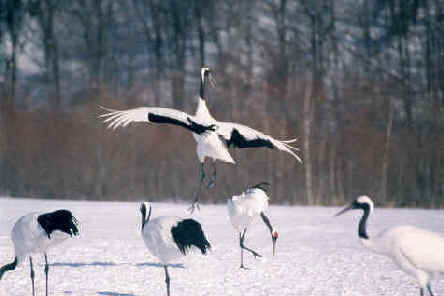
Red-crowned Cranes were seen, and
enjoyed, again
during the FONT Japan Tour
on Hokkaido in January 2007
![]()
Links:
List of Birds during our Spain Tour - April 2007
Cumulative List of Birds during our Spain Tours
Upcoming FONT Birding & Nature Tours in Europe
![]()
Links:
List of Birds during our Dominican Republic Tour - April 2007
Cumulative List of Birds during our Dominican Republic Tours
Upcoming FONT Birding & Nature Tours in the Caribbean
![]()
Links:
List of Birds during our Puerto Rico Tour - April 2007
Cumulative List of Birds during our Puerto Rico Tours
Upcoming FONT Birding & Nature Tours in the Caribbean
![]()
Links:
Lists of Birds & Other Wildlife during our Belize Tour - March 2007
Cumulative Lists of Birds & Other Wildlife during our Belize Tours
A Photo Feature from our March '07 Belize Tour
Upcoming FONT Birding & Nature Tours in Central America
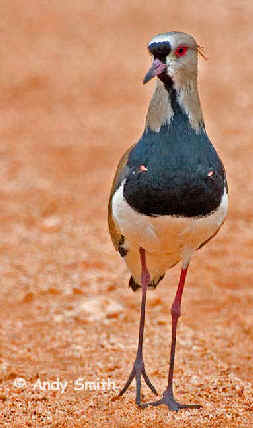
Not that long ago, the Southern Lapwing
(pictured above),
a common bird in South America,
occurred in Central America about as far north
as the Panama Canal.
More recently it's spread into Costa Rica
(where during our tours we've seen adults at a nest).
During our March 2007 tour in Belize,
we saw a Southern Lapwing at Crooked Tree.
We're told that it appeared there over a year
prior to our tour - and it stayed.
The following account was written by Armas Hill, leader of the tour:
Since
1991, there have been 55 FONT birding & nature tours in Central America.
About half of those tours have been in Costa Rica (27). About half that many
have been in Guatemala (14). There have also been 9 FONT tours in
Panama, and 3
in Honduras. All of the countries just mentioned are wonderful destinations for
tours to see birds and other nature. But, there's also another Central American
country that's tremendous in that regard. It's
BELIZE. Our
March 20-30, 2007
tour in Belize was only the second tour for FONT in that country. The other tour
was back in 1992. Fifteen years later, I must say, we were so struck by how very
good Belize is for a birding & nature tour, we'll just have to go back --
and soon (certainly sooner than in 15 years) !
There are a few reasons why Belize is a good country for nature. The bottom
line, of course, is that it's there. Beyond that, even though Belize is a small
country, there's good diversity in its habitats. And, throughout the country, on
the whole, there are not many people - thus, nature "has a chance".
From a practical perspective, there are a couple other things in Belize's favor.
It's not that far, as the plane flies, from the US, and, generally speaking,
English is the language spoken.
Yes, Belize is a small country. It's true that none of the Central American
countries are very big. Most are smaller than a number of US states. But, Belize
is the second smallest country in Central America, after El Salvador. Its
longest distance, north to south, is about 280 kilometers, and from east to west
it's over 109 kilometers at its widest point. Note that these distances are
kilometers, not miles. A kilometer is just over half a mile.
Even though Belize is small, as many over 500 species of birds have been
recorded within its borders. In a monograph written in 1964, the number of birds
noted as being in the country was 465. About 20 years alter, in 1986, a
checklist of birds in Belize was published with 533 species. In 2000, another
checklist for the country included 549 species of birds. That number of Belizean Birds
has
increased since then - at least by one. The Southern Lapwing (pictured above)
was not in that list. We saw a Southern Lapwing during our March 2007
Tour. The single individual was at a well-known place for birding in Belize,
called
Crooked Tree.
And, it was said, that the single bird had been in that
area for about a year. It's interesting, of course, that a rarity like that for
the country, and a species that's been a colonizer spreading north in Central
America, would appear, and then stay, at one of Belize's foremost birding locations.
But that it did.
As can be surmised from the last paragraph, some of the over 500 species of
birds in Belize are not plentiful. There are some species with just a handful of
records. But most of the Belizean birds are not rare in the country, either the
residents or the migrants. About 370 species of Belizean birds are residents.
Not only are there a good number of birds in Belize. Also, about 150 different
species of mammals have been recorded in the country. Even after subtracting the
bats, there's still a fine assortment of mammals, including: howler and
spider
monkeys, a couple species of deer, in addition to armadillos, peccaries,
agoutis, coatis, opossums, and kinkajous. In coastal waters, there are
manatees.
The biggest land mammal in Belize is now the national animal of the country.
It's the Baird's Tapir.
But, probably the most "well-known" of Belizean animals may actually
the "least-known" in the sense that they are secretive and nocturnal.
They are the cats, such as the Puma, the Ocelot, and above all, the
Jaguar.
Belize, for a small country, has a lot of Jaguars - certainly more, at least for
the size of the country, than in other places in Central America. And that's not
including those that are everywhere on postcards!
During our March '07 tour in Belize, we, unfortunately, did not see a Jaguar.
But, we did see the large tracks of that big cat in the mud.
There will be mention, later in this narrative, of the various animals that we
did see in Belize.
Offshore, just off the seacoast, beyond the islands known as "cayes",
there's yet another world of Belizean nature. Underwater, it's rather like a
giant tropical aquarium. At the barrier reef (the second largest in the world),
with its sponges and sea-fans, there's a cast of characters that includes: parrot
fish, angel fish, and squirrel fish, many of which are colorful. There are also
Nurse Sharks, Marlin, Barracuda, and various rays, spiny lobsters, sea urchins,
conches, and sea turtles, including the Hawksbill. Some of our tour participants
entered this underwater world and they saw nearly all of the creatures just
mentioned.
Earlier, it was said that there's "a good diversity of habitats" in
Belize. The number of native plants in the country supports that statement. In
little Belize, there are over 4,000 kinds of plants. There are about 700 species
of trees, that are either of two types of forest: one that termed "tropical
forest", and other the pine, or savannah, forest. In the luxuriant tropical
"rainforest", some of the notable trees include: the Mahogany
(the
national tree of Belize), the Silk Cotton (the sacred tree of the Mayan people),
the Sapodilla (the source of chicle, used in making chewing-gum), and the
Cohune Palm (a tree from which oil is extracted and the leaves of which are used to
thatch Mayan huts).
In the dense tropical vegetation, many trees are entwined with creepers and
other epiphytic plants.
There are about 250 varieties of orchids in Belize. The Black Orchid is the
country's national flower.
In the pinewoods and savannahs, the Caribbean Pine is the most widespread
species of tree in Belize.
Near the seacoast, there are impenetrable areas of mangroves. Also along the
coast, there are Coconut Palms, and other types of palm
trees.
Nearly 75 per cent of the land in Belize is still dominated by natural
vegetation. It was noted earlier that there are "not many people in
Belize". The country has less than 10 inhabitants per square kilometer.
That's the lowest population density in Central America. The total population in
the country is less than 225,000. And half of those people live in towns, which
are mostly near the coast. In Belize City, on the coast, there's a quarter of
the population of the country.
In most of the country, the villages are separated by vast expanses of
uninhabited land, usually forest. "Vast" is a relative term. To
qualify, the expanses are "vast" in terms of Belize.
Anyway, as we drove about the country, on most of the roads, away from Belize
City, and excluding the main east-west highway, there was very little traffic.
Thus, the birding from the road, and the driving in general, was rather
idyllic.
Even though there are not many people in Belize, there's also a
"diversity" in Belize in that regard, as there is in its nature. There
are different people called various names: the Creoles, the Mestizos, the
Garifunas, and the Maya, in addition to more-recent immigrants including the
Mennonites, Chinese, Indians (from India). some British who did not return home
after colonial days, and some Americans (from the US & Canada) who came to
make a new home.
Here's a bit more about the groups of people and cultures in Belize:
The Creoles descended from African slaves and Europeans. At about 30 per cent of
the Belizean population, they are now the second largest ethnic group in the
country, after the Mestizos. For a long time they have been the primary social
group in the country, notably in and near Belize City. Their language, a
colorful mixture of English and African languages, is spoken throughout Belize.
The Mestizos, now about 45 per cent of Belize's population, are the result of
intermarriage between the indigenous peoples and Europeans.
The Garifunas originated on thee island of St. Vincent in the 17th Century from
intermarriage between shipwrecked Africans and Kalinagos (indigenous Caribbean
people). In Belize, they live mostly along the southern coast, and make up less
than 10 per cent of the country's total population.
At about 10 per cent of the indigenous population of Belize today are the Maya.
They all but disappeared after the colonization of the country. Prior to that
(during what's called the "Classic Period"), there were many. The
Mayan people now in Belize are of 3 groups: the Yucatec Maya (refugees from the
War of the Castes), the Mopan (from the El Peten region of Guatemala - the area
of the ruins of Tikal), and the Kekchi (from the Coban region of Guatemala -
where during FONT tours in that country, we see the Resplendent Quetzal). The
last 2 of these groups, those from Guatemala, fled that country in the 19th
Century and settled in Belize in the Cayo District and the Toledo District
respectively.
Our contact with these Mayan people during our March '07 tour was most
interesting for us.
In the Cayo District, when we had a flat tire, along a road in the "middle
of nowhere", the Mayans helped us - taking the bad tire to their
settlement, fixing it, and then coming back and getting us "ready to
go".
In the Toledo District, we actually stayed "with the Mayans",
overnight, near the
Cockscomb Basin Wildlife
Sanctuary. Some of our best birding
was there, by the cabins where we spent the night. But, that's not all. Some of
the best food we ate during the tour was there too. One of our tour participants
celebrated a birthday, that day there. Not to give his age, but he's in his
eighties. The birthday cake that we had that evening, seemingly made miraculously
(on
very short notice), was one of the best birthday cakes ever made -
anywhere.
(A side-note: The Mayan people in that area formerly lived on the land that's
now the wildlife sanctuary just-mentioned, Cockscomb - a great sanctuary, best
known as one for the jaguar, but also, as we experienced, it is a wonderful place
for birding. The Mayan settlement, where we stayed overnight, and ate (the cake
and otherwise), was where the people had to move, just outside the
sanctuary.)
We actually birded, during our Belize tour, in areas with all of the cultures just
mentioned.
We also visited a ranch in central Belize, where some Americans settled, to
farm, years ago.
Additionally, we spent a night at the hotel on the tip of a peninsula (water was
on 3 sides of the building). It was near a large coastal zone of mangroves, where offshore
Manatees were in the water. Also
at the hotel when we were there, was a crew, there to census, and tag, the Manatees;
along with
another crew also at the hotel to do a film about those doing the tagging and those
(the Manatees that is) being tagged. We took a boat-ride in the afternoon,
during which we had looks, ourselves, at the sluggish Manatees.
Near that hotel, is where, at night, the Jaguar track, referred to earlier, was
first seen. The next day, we all saw it (that big track).
We spent a couple nights, further east, on one of the offshore barrier islands.
On that island, we saw the most tourists during our time in Belize. But that
was OK. We also saw some very nice birds.
There are no cars or trucks on that
island. Our birding was either on foot, or as we traveled about on a golf cart
on the unpaved roads on the island.
Birds that we saw, there and elsewhere,
during the tour will be noted in a moment. Now, I'm simply conveying some of the
"diversity" that we experienced, at the places we visited, during our
10 days in Belize.
We also stayed at a lodge in western Belize, overlooking a valley, that of the
Macal River. A number of "lodges", fine for birding and other nature,
have recently sprouted up in that part of the country, the
Cayo District.
In a nearby town, we had lunch one day at the restaurant in a hotel where Queen
Elizabeth II stayed and ate when she visited - Belize a few years previously. Even
when we were there at mid-day, we saw some nice birds (Yellow-throated
Euphonias) from the deck of that
restaurant. I wonder if the queen happened to notice any nice birds when she was
there on that
balcony.
After lunch, that day, at a botanical garden, a few miles away, we saw a bird that
spends mid-day doing nothing, other than sleeping. It was a Northern
Potoo,
motionless, blending in on the branch of a big tree.
A few miles to the north, in that
Cayo District
of western Belize,
are the
agricultural lands of the Mennonites. They are one of the groups, mentioned here
earlier, in the overview given of the people in Belize. Relative newcomers, they
settled in Belize in the 1950s, having come from Europe by way of Canada. Mennonites are members of an
Anabaptist sect that was founded in Switzerland back in 1536. They're readily
noticed as they adhere to their own way of dress (the women with long skirts
& headscarves; the men with "cowboy hats" & dungarees), and
they prefer a modest life, living unto themselves in their communities, which
usually are related to farming. That they have blue eyes, blond hair, and a dialect
reminiscent of their Swiss and Dutch origins, also sets them apart from the
other people of Belize. The area of Mennonite farms in the Cayo District is, of
course, not part of 75 per cent of Belizean land, referred to earlier, as
"dominated by natural vegetation". Even so, that region is still a
good area for a number of birds.
Our local guide (from the lodge where we stayed above the river valley, the
"Crystal Paradise") arranged for us to enter the Mennonite farmland on
the dirt roads, going beyond where we otherwise could have, as he had a key for
a gate. Beyond that gate, was a pond, and near it, in a grove of tall trees,
there was a big Jabiru nest. We saw, at the nest, the birds. The big adult Jabiru
stood there for a while, and then it flew.
The open country of farmland was good for other birds, notably those loosely
called "field birds". And for raptors too.
In every FONT tour narrative, there's a lot said about birds. Before the summary
of birds (and animals), this time, during the FONT March 2007 Belize tour,
here again is a quick reference to the "diversity" of Belizean natural
habitats. Those that we visited, and in which we birded, in Belize included:
lowland broadleaf forest, submontane pine woodland, lowland pine woodland and
savanna, seasonally wet meadows, marshes and lagoons, mangrove and littoral
forests, islands along the seacoast, and various man-altered habitats (such as
the farmland described in the previous paragraph).
The first place that we went, after our arrival in Belize, was the area of
marshes and lagoons called
Crooked Tree. As noted earlier, that area is one of
the renowned birding locales of Belize. And that it is with good reason. It's
birdy.
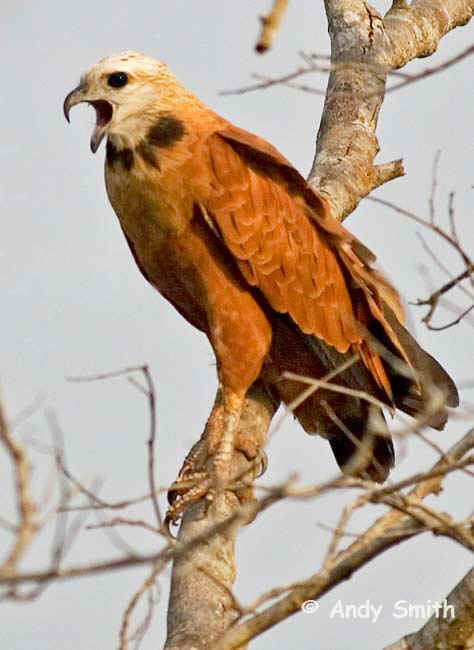
Black-collared Hawk
This is a raptor readily seen in Belize,
although not so in Guatemala & Costa Rica.
It's a common bird in parts of South America,
nearly always by water.
The village of
Crooked Tree,
itself, could be described as a rather sleepy place. It's known, for of all
things, cashews. For birders, it's a wonderful place to begin a tour in Belize
as we did.
The waterbirds included, for us, an assortment of egrets &
herons, and terns & gulls. There were also Limpkins, Northern Jacanas,
Purple Gallinules, and numerous Neotropic Cormorants. Wood Storks flew overhead,
and Glossy Ibis were along the shore of the lake. Crossing a lightly-traveled
road, ahead of us, was the Gray-necked Wood Rail. Raptors that were about
included Black-collared Hawks, Snail Kites, and Great Black Hawk, in addition to
Osprey, Roadside Hawk, and Lesser Yellow-headed Vulture.
At the pleasant little hotel where we stayed, by the shore of the lake,
Gray-breasted Martins were also setting up house. On the nearby pasture, there
was the lone Southern Lapwing referred to earlier. The next morning, that
Lapwing was on the ground right outside our windows. Noisy that bird was, in
fact it was our wake-up call.
Not as raucous, but also loud enough, that morning, were the Red-lored Amazon
Parrots, calling as they flew. Flycatchers in the area, aside from the
Kiskadee,
were generally quiet. But the Vermilion and Fork-tailed Flycatchers were, as
always, great to see, flying about as they were catching insects for their
breakfast.
As we ate our breakfast on the porch (where the typical Belizean food was
wonderful), we had another treat, with the company of a Yellow-throated Warbler
that actively cavorted on tables, ceiling lamps, and the balcony edge. Warblers,
on the whole, are wonderful, and this little Yellow-throated was especially so.
The "most famous" of Crooked Tree birds, the Jabiru, we did not see
during our time there. Maybe that time was just too short. (We liked the place so
much, that was how we felt anyway.) In the area, the Jabiru is pictured on sign after
sign, but look as we did, the actual bird was not to be seen. We were to see it,
however, a couple days later, in western Belize, as was noted a couple
paragraphs ago, by a pond in Mennonite farmland.
A few miles east of Crooked Tree, there's a Mayan archeological site called
Altun Ha. It was a flourishing city in the "Classical period" about
600 BC. In that area, we did well, about 2500 years later, looking at birds.
Among them were: the Aztec Parakeets, both Black-headed and Violaceous
Trogons, the
Collared Aracari, and its larger cousin, the national bird of current-day
Belize, the Keel-billed Toucan.
Some local guides took us on a new track into a nearby tropical forest. The
vegetation there was dense - amazingly so. The area really was "wild". Near the
toucans in bare treetops, there was a pair of Bat Falcons. Close to the ground,
White-breasted Wood Wrens beautifully sang. Apparently, at least, the most common bird in
the area was the Montezuma Oropendola. Those crow-sized yellow-tailed birds were
fine to see as they flew one after the other. But, they were even finer to hear,
when we heard a chorus of their gurgling
calls.
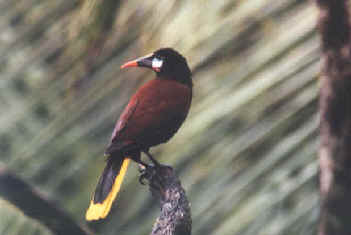
Montezuma Oropendola
Late in the afternoon, we headed west, on the main Belizean east-west road,
toward Guatemala. We weren't going quite that far, but into the
Cayo District
of
western Belize.
Just after dark, with about a half-hour to our destination, we
had a marvelous experience, even along that main road. On fenceposts by the side
of the road, we saw Barn Owls - a half-dozen or so, on as many posts, all within
about a mile of each
other.
In the
Cayo District, where we stayed a couple days, we saw many birds, about
120 species. By the lodge, along with others, there were these notables: Blue-crowned
Motmot, Green Jay, Rose-throated Becard, White-necked Jacobin,
other hummingbirds, and a number of Flycatchers including the vocal Piratic.
And there was the
also-vocal Barred Antshrike, in addition to the Masked Tityra, Ivory-billed Woodcreeper,
Golden-olive Woodpecker, and Yellow-green Vireo.
Also visiting, as we were, from North America, were Wood Thrush, Gray
Catbird,
and various warblers.
When we went, one day, a few miles north to the Mennonite farmlands, primarily
as already noted for the Jabiru, we saw another cast of avian characters - those
of the open country. There were raptors, such as the White-tailed Kite
&
the White-tailed Hawk, the Gray Hawk, and the Laughing Falcon. Throughout the tour,
incidentally, we were to find Laughing Falcons to be surprisingly common - we
saw the species nearly every day (except when we were an offshore barrier
island).
A surprise during the day when we were in the Mennonite farm country was an
encounter with about 3 dozen Blue Ground Doves, along a shrubby edge of a field.
Throughout the tropics, we don't normally find that species in a such a large number.
Birds of the open country included the local race of the Eastern Meadowlark,
Blue Grosbeak, its smaller cousin the Indigo Bunting,
2 species of seedeaters
(the White-collared and the black race of the Variable) and 2 species of
grassquits, in addition to Vermilion Flycatchers and Fork-tailed
Flycatchers,
neither of which did we mind seeing again and again.
Not far from the already-mentioned Jabiru nest, there was a colony of bird
nests, also interesting, in a dirt bank. Somewhat like a colony of Bank
Swallows, but they were not. What they were was a local breeding population of
Rough-winged Swallows, said to be a distinct species from the widespread
Northern Rough-winged Swallow. The Northern Rough-winged Swallow breeds further
north, mostly in North America. The colony of nesters that we saw are called the
Ridgway's Rough-winged Swallow. Their nests appeared to be active when we were
there in March.
At the nearby pond's edge, there were Solitary and Spotted Sandpipers
(that
would later go north to nest) and Bare-throated Tiger Heron (that would stay in
the area). In a small patch of adjacent woods, there was a pocket of warblers,
all of which would later go north. Notable among them was a bright Prothonotary
Warbler. That species is not common inland in Central America. Its favors the
coast, especially areas in and near
mangroves.
As we traveled around that afternoon, some of the roads went into wooded areas.
There we had looks at Squirrel Cuckoo, Lineated Woodpecker, the common and noisy
Brown Jay, Red-throated Ant-Tanagers, and other Tanagers such as the
Yellow-winged and Golden-hooded. During the course of our ride that afternoon,
in mixed habitats, we heard 4 species of Tinamous: the Great, Little,
Thicket,
and Slaty-breasted. The presence of tinamous can be said to be a good barometer
of a Neotropical environment. As mentioned earlier, along the back roads in
Belize, away from the towns and villages, there's more nature and less people
than along most such roads elsewhere in Central
America.
In another note pertaining to the
Cayo District, mention is made now again, of
the Northern Potoo that we saw sitting completely still on a big tree branch in
the middle of the afternoon. It may have moved a closed eyelid, once, but it
never moved another muscle as we walked about below it. The Northern Potoo is a
species with races in northern Central America, and on the Caribbean islands of
Jamaica and Hispaniola. It's not, now, the same species as the Common Potoo,
that's in South America and Central America, on the Caribbean side, north to
Nicaragua.
We did not see the Northern Potoo later in the evening, or after dark, when it
would be active. At that time, we were elsewhere, but at dusk that day, two
other species active after sunset were seen, the Yucatan Poorwill and the
Pauraque. They were both in the vicinity of our lodge. The Pauraque has a
widespread range, from Texas to Argentina. The Yucatan Poorwill does not. It's
restricted to its namesake, the Yucatan Peninsula of Mexico and adjacent
Guatemala and Belize.
We went to high hills in central Belize, covered with mile after mile of pine
trees. The Pine Warbler has never been recorded as far south as Belize, but in
those trees, there were Grace's Warblers - a species that's said never to
occur outside of a pine. Overhead, in the sky, we watched soaring Swallow-tailed
and Plumbeous Kites. One can not help but watch soaring kites.
At the edge of the high pine-clad plateau, we went to the top of a high
waterfall, called Thousand Foot Falls (that's how high it is). The vantage point there
can be a good place to see Orange-breasted Falcon. It wasn't when we were there.
We looked - and looked. The Black Vultures, that were present, were
extremely acrobatic, in the updrafts. Other birds that we did see in the area
included: Hepatic Tanager, Yellow-tailed Oriole, Rusty Sparrow, and Black-headed
Siskin.
In just about the middle of the country, another place where we saw birds in
March '07 was a place that was visited during a FONT tour back in 1992. It's
called
Banana Bank. It wasn't, in some ways, the same as it had been 15 years
earlier, but in other ways, it was. It's a working ranch, with horses and
fields. The buildings are by Belize's largest river. The size of the property is
vast. Dirt roads go throughout. Here, we saw our first King Vulture during the
tour. It was big, yes (bigger than the Black or the Turkey
Vultures), but it was
black also - all black. It was a juvenile.
Banana Bank was also a good place for us for becards. We saw two species there
that are not seen as often as some other birds, the Gray-collared and the Cinnamon
Becards. The Gray-collared Becard was seen in a large tree, as we were
sitting on reclining chairs by the swimming pool. It was there until it was
displaced by a flock of Collared Aracaris.
Also on the property of Banana Bank, we saw our only Merlin, Dusky-capped
Flycatcher, and Hooded Warbler during the tour.
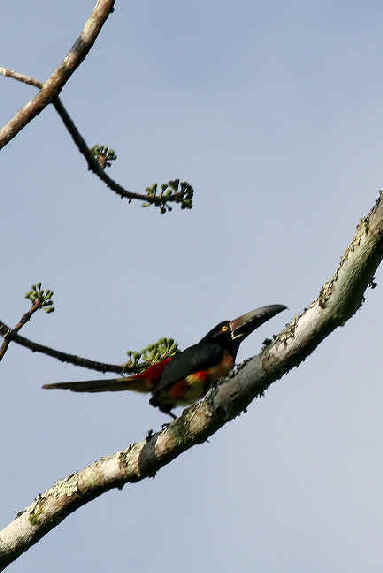
Collared Aracari
When we traveled south along the
Hummingbird
Highway, we didn't take notice of
any (hummingbirds that is), but we did see 3 species of Orioles
together: the Hooded, the Yellow-tailed, and the Baltimore.
Along the southern seacoast of Belize, near and in
Placenica, we saw
"development", the most construction that we saw in the country. New
condominiums were in the making. Other were made. At marinas, there were yachts.
Those who were sailing them would stop by for a while in the town, before continuing on.
One of the birds that we saw in Placencia was one that's arrived recently in
Belize. On a wire, it was a Shiny Cowbird. That species, common in South
America, has recently spread north in the Caribbean on West Indian
islands, and even further north into the southern
US.
In the book, "The Birds of Belize" by H. Lee Jones, published in 2003,
the Shiny Cowbird is included. But it's written that the species
"is not yet recorded in Belize, although likely to reach the country in the near
future". As just stated, the bird has only recently spread north in the
Caribbean. The common cowbird in Central America is the Bronzed Cowbird,
occurring south to Panama.
Near Placencia, we saw our only Common Black Hawk during the tour, not on a
utility wire, but atop a utility pole, close to us, along the road just outside of town.
One of the best of places for birding that we visited during '07 tour in Belize
was the
Cockscomb Basin
Wildlife Sanctuary. It's well known as a reserve for the
Jaguar. But, of course, there's so much more there! And, during our visit,
we had the good fortune
to see quite a bit.
In contrast with the Black Hawk, earlier by Placencia, we saw, from along the
road in Cockscomb, the White Hawk. What a magnificent bird it is! We observed it
perched against the green canopy of the trees along the road ahead of us.
There were a number of truly wonderful birds for us along that road. To name a
few:
On the ground, the Ruddy Quail-Dove walked.
Overhead, Red-lored Amazon Parrots flew.
On a branch, and still for a while, there was the Slaty-tailed Trogon.
In a small tree, there was the small Smoky-brown Woodpecker.
In larger trees, a pair of larger Pale-billed Woodpeckers were great to see. That
species is in the same genus as the Ivory-billed Woodpecker, a North American
species that would be great to see.
At about eye-level coming out and then going back in the foliage, the Dusky
Antbird appeared and disappeared.
Also in the low foliage, at a lek, White-collared Manakins nicely
performed.
Another bird was nearby in that foliage used to be called a "manakin". Now, it's
the Thrush-like Schiffornis - its call was heard, then the bird was
seen.
In the distance, the calls of both Great and Little Tinamous were heard.
Very close to us, some small birds with yellow foreheads and chestnut bellies
ate fruit. Those features notwithstanding, the birds instead are named after the
color of their backs. They're called Olive-backed Euphonias.
With some bright red coloration, there were Tanagers: the Crimson-collared, the
Passerini's (that used to be called the Scarlet-rumped), and the male
Summer Tanager.
With bright red legs, the Red-legged Honeycreeper is aptly named. Otherwise,
it's a brilliant
blue.
At the edge of the forest, there was a hummingbird called the White-bellied
Emerald. At flowers, there was the Rufous-tailed Hummingbird.
Also favoring the gardens, not far from the forest, by the cabins where we stayed,
there was the
dapper Common Tody-Flycatcher. In that wonderful area, nice birds seemed to be
everywhere.
A day or so later, we took a boat-ride, for about an hour, to a place called
Bird Island. Located east of the mainland, in an area of sheltered bays, coves,
and numerous little islands, that one particular island is quite a place.
Just as they're can be only very few people along some the roads in Belize,
there are less yet along the route we took in the boat. Oh, we saw a few
fisherman in small boats, with nets, catching fish. But not many. It was quiet,
and an extremely nice late afternoon as went across the water. Osprey were in
the sky. We had just seen another all-dark immature King Vulture. On a snag, on
an island a short distance away, we saw two Peregrine Falcons.
Then we saw Bird Island, with many birds indeed. Like ornaments, late that
afternoon, they were in the trees.
Most were White Ibis. But there were Egrets and Herons as well. The Egrets
were:
Great and Snowy (no Cattle). The Herons were:
Great Blue, Little Blue, and Tricolored. Many of these birds had just come in to the island. The
Black-crowned Night Herons were coming out. When we got closer, we observed
another member of the tribe, as there were Boat-billed Herons standing on
the branches in the
tangles.
The last place that we visited in Belize was another island, an enjoyable one on
which to stay. Miles offshore, further north in Belize, it's the barrier island
called
Caye Caulker. It's small, that island, only 7 kilometers long and less
than a kilometer wide. Just east of the caye (pronounced "key"),
there's part of the coral reef for which Belize is so well known. Until
recently, most of the residents of Caye Caulker were fisherman, of conch or
lobster. Now, there's more tourism, but, due to its smaller size, the island
doesn't have as much hustle and bustle as Ambergris Caye to the north. During
the 1992 FONT tour in Belize, we stayed on Ambergris Caye.
During the last part of our 2007 Belize tour, on Caye Caulker, we certainly had
a fine finale to our birding. On that small island, we found nearly 50 species
of birds. The best of them included the Black Catbird, Yucatan Vireo,
White-crowned Pigeon, Scrub Euphonia (a rarity there on the island), and
Mangrove Warbler. As to the last of these, we had a great look or two at the
attractive and colorful male.
At a small nature reserve (a patch of natural vegetation), there were actually
both of the New World's catbirds. The Black Catbird is an uncommon resident of
the area, with a restricted range (it's considered a threatened species). The
Gray Catbird, that was also there, is, of course, a migrant, that goes to North
America to breed.
We saw two species of hummingbirds on Caye Caulker: the Green-breasted Mango and
the Cinnamon Hummingbird. Both were fun to watch.
But maybe the bird on Caye Caulker that was most fun to watch was the
Magnificent Frigatebird. In the late afternoon, especially, when the fisherman
were preparing their day's catch on the piers, the frigatebirds would come in so
closely. The birds, though large, have such a light weight that their buoyant
antics in the air make them very much a sight to see - by the sea. Actually, as
a runner-up in that category, the Brown Pelicans, also coming in close to the
fisherman, are rather "watchable" as well.
In all, throughout our 10-day tour in Belize, we saw a number of birds that
were, to use that term, "watchable" for sure!
And we saw some mammals
too. In addition to the West Indian Manatee, mentioned earlier, we saw:
White-nosed Coati, Red Brocket Deer, Paca, and Yucatan Squirrel. The
Yucatan
Black Howler Monkey was heard. It was hard not to hear it. The loud calling of
the male certainly carries, as far away as a mile.
Many of the animals have interesting Belizean names. The Yucatan Black Howler
Monkey is called the "Baboon". The Red Brocket Deer is called the
"Antelope". The White-nosed Coati is called the "Quash". The
Manatee, the "Sea Cow". And maybe with the nicest name of all, the Paca is
called the "Gibnut". That animal is like an Agouti with spots.
Some of the other wildlife during the tour were: large Tarpon fish near the
Manatees, Iguanas, Leaf-cutter and other Ants, and a wonderful assortment of
butterflies.
During our
March 2007 tour,
there was so much to observe, and enjoy, in
Belize:
the birds (of course!), the other nature, the people, and the
country itself! Belize is really a great "natural
destination".
![]()
The Dominican Republic (& adjacent Haiti)
February/March 2007
Links:
Birds & Other Wildlife during our Dominican Republic Tour in Feb/Mar. '07
Cumulative List of Birds during our Dominican Republic Tours
Upcoming Caribbean Tour Itineraries
![]()
Links:
Birds & Other Wildlife during our Honduras Tour in Feb. '07
Cumulative List of Birds during our Honduras Tours
Upcoming Central America Tour Itineraries
![]()
Links:
Birds & Other Wildlife during our Japan Winter Tour in Jan '07
List of Birds during FONT Japan Tours in 2007
Cumulative List of Birds during our Japan Tours
Upcoming Japan Tour Itineraries
The following account was written by Armas Hill, leader of the tour:
During our January 15-30, 2007, Japan Winter Birding
Tour, which was the 27th
FONT birding & nature tour in Japan, and the 17th such tour in the winter, among the highlights,
as always, were the cranes and the eagles.
During this tour, there
were 5 species of Cranes (Red-crowned, White-naped, Hooded, Common, &
Sandhill), and large numbers of both Steller's Sea-Eagles and White-tailed
Eagles were observed.
And once again, as during every FONT Japan tour in the
winter, we saw the big & rare Blakiston's Fish-Owl.
Other notable bird
species during the tour included: Copper Pheasant, Solitary Snipe, Black-faced
Spoonbill, Spectacled Guillemot, Long-billed Murrelet & other alcids, Laysan
Albatross, Mandarin Duck, and Hodgson's Hawk-Eagle.
During the tour the 3 main
Japanese islands of Honshu, Hokkaido, and Kyushu were visited. Lastly we went to
the smaller island of Amami, where we saw the bird specialties (endemic or
nearly-so) including: the Amami Woodcock, Amami Thrush, Lidth's Jay, and
Ryukyu Robin.
During this tour Japanese Macaques (or "Snow Monkeys") were
seen on 2 islands, Honshu &
Kyushu.
The above paragraphs put in
capsule form some highlights of the tour. A more descriptive narrative follows:
All of our Japan tours begin on the main Japanese island of Honshu.
That's because the Narita International Airport, northeast of Tokyo, is the
major gateway into the country. And so it's good fortune that the birding on
Honshu can be extraordinarily good, no matter what season we are there. It's
because Honshu is a large island, and with varied topography. There are open
flat lowlands and there are forested mountainous highlands. Yes, there are
people, many of them. But it's interesting that, throughout Japan, 80 per cent
of those people live on 20 per cent of the land. And so, it's surprising to many
who have traveled in Japan with us, over nearly 20 years, that one doesn't
really have to go far from Tokyo (or Narita) to find countryside where there's
nature and some good birding.
During our 2007 Japan Winter Birding Tour, after we arrived on Honshu, we went first to some open, flat
lowlands, not very far from Narita. In a river valley, with islands with
agricultural fields and areas of reed-beds, we saw a nice number of 2 species of
Harriers (the Eastern Marsh, and the Northern, or Hen)
hunting over the fields. In the reeds, we found 2 species of aptly-named Reed
Buntings (the Common and the Japanese). The second of these we
normally find in that area during our tours in the spring. It was warm that
January day, seemingly almost as warm as when we visit in May. A Ruddy-breasted
Crake was heard calling in the reeds.
We traveled downriver a bit to where it meets the ocean, and where there's a
large fishing port. The riverbanks there are literally covered with birds. There
are many cormorants and ducks, and almost more gulls than
can be imagined. When we there in the afternoon, the fishing boats were coming
into port. Above the dozens of boats with their catches, there were swarms of
gulls, thousands of them - in the sky, on the water, on the ground, on roofs,
everywhere. Even for those not as fond of gulls as they are of other birds, it
was a spectacle to behold with much to observe as there were 8 species of Gulls
in an assortment of plumages: Common Black-headed, Black-tailed, Kamchatka
(or Mew), Vega (formerly Herring), Slaty-backed,
Glaucous-winged, Glaucous, and Black-legged Kittiwake.
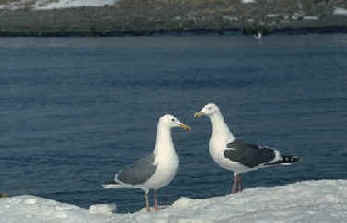
Just two of many gulls
along the Japanese coast.
Vega Gull (left) & Slaty-backed Gull (right)
Some Japanese birders were
looking for Thayer's Gull (at a traditional spot for it). They hadn't
found it when we spoke with them (in a little English and a little Japanese),
but they did tell us of a Black-faced Spoonbill on the other side of the
river. We thanked them and went to the said-spot hoping to see the rare bird.
And that we did. The Black-faced Spoonbill is one of the rarest birds in
the world. It's total population is said to be under 700 birds that breed
locally in Korea and China. Every year some winter in Japan, usually in the
southern part of country. We've seen it during our winter tours previously in
Kyushu, Okinawa, and Amami (1 bird once on the last of these). This was the
first time (in 17 winter tours) that we saw the bird in Honshu.
Our afternoon at the fishing port ended by a sheltered cove, where we watched grebes
and cormorants fishing in the clear water beneath us. The Cormorants
were the Japanese (or Temminck's). The Grebes were of 3
species: Great Crested, Red-necked, and Horned. The small fish in
the water there were plentiful. Oh yes, there were ducks there, too. Ducks,
of a number of species, are also plentiful in the winter in Japan.
The next day we were in a completely different world. We were still on Honshu,
but we had driven just over 2 hours to an area of forested hills. We spent the
night in wonderful little hotel in the forest, with a Japanese hot bath (or
onsen). As the day began, outside the window as we had breakfast, birds were at
the feeders. Some light snow was falling. It was, simply put, a beautiful
setting (and, as noted, one almost wouldn't believe that in this woods we were
just a short drive from the sprawl of Tokyo). Among the birds at the feeders,
there were a number of Japanese Grosbeaks and some Varied Tits.
Stepping outside, when we'd put seeds into the palms, the Varied Tits
would land on our hands to have their breakfast.
At another feeding station nearby, with not only feeders with seed and suet,
there was some open water, much like a spring. There we were treated to good
looks of the endemic Japanese Accentor, the Northern (or Winter)
Wren, and the Yellow-throated Bunting by the water, in addition to
the regular cast of characters including an assortment of tits, nuthatch,
woodpeckers, and finches.
Between the two sets of feeders, out in the woods, a stream with open water
flowed where otherwise there was snow on the ground and the trees were bare.
From along the edge of that stream, a Solitary Snipe flew up into the
sky. That species winters at such spots in the forested hills of Japan. Alone,
as it is, after all, the Solitary Snipe. This one bird was the first for us
(again, in 17 tours in the winter). The species is not in Japan outside the
winter, as it breeds in places such as Siberia and Manchuria, not alone but only
in pairs spread out with nests in remote locations. Ours was a nice bird to see.
In the stream itself, there were Brown Dippers in the water, also nice to
see. The Brown Dipper of eastern Asia, Cinclus pallasii, is named after Peter
Simon Pallas, who lived from 1741 to 1811. He was the most eminent
explorer-naturalist of his day. One of his journeys was a 6-year expedition
(1768-74) across Russia, east from St, Petersburg to Lake Baikal and beyond. One
can wonder if he ever encountered the Solitary Snipe where it breeds in that
remote region "beyond".
During our time in hilly, central Honshu, there were a couple other notable
sightings. Late in the afternoon, as it was getting a bit foggy, a Ural Owl
flew in front of us as traveled along a road. It was seen nicely, but it would
been good if we could have found nearby perched in a tree.
The next morning, when there was a bright blue sky, the treelimbs in the forest were
covered with a layer of snow. It was a beautiful morning, which could have been
better with just one thing. We were trying, before we had to leave the area, to
see a bird that's always at or near the top of the "most-wanted list"
for most birders visiting Japan. The bird: the endemic Copper Pheasant.
On the fresh snow, at the edge of a side-road, we saw fresh tracks. And, then,
shortly later, near that spot, it was as good as it gets when a male Copper
Pheasant walked out in front of us, as we sat in our vehicle. For a while, the
bird stood still, and thus, we got a long look at that exquisite bird with the
long tail! Yes. it was as good as it gets.
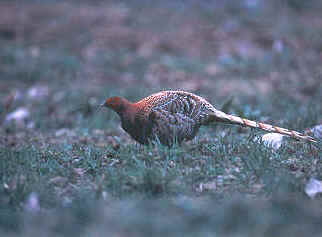
A male Copper Pheasant
The birds noted so far (after
the first paragraph) were all on Honshu, where, yes, as it's been said, the
birding can be "extraordinarily good". But, really, during our Japan
Winter Tours, it's the birds of Hokkaido and
Kyushu that normally get the top-billing -
the cranes, the eagles, and the Blakiston's Fish-Owl.
To go from Honshu to Hokkaido, we have, over
the years, taken an overnight ferry as a pelagic trip on the Pacific. And that
we did again in January '07. The ferry is a large boat, on which after boarding
we sleep, and then all-day offshore we can scan the sea for birds. We were this
time as the boat has a good, big enclosed area in the front end of the boat,
from which we could see the sea ahead of us.
In recent years, for whatever reason, we have not been seeing, during this trip,
as many Laysan Albatrosses as we did in the past. In '07, however, that
trend was reversed. Maybe it was because we could watch ahead of us continuously
in comfort, but this time we saw about 50 Laysan Albatrosses flying in
their distinctive style above the water.
And having the good area for observation certainly enabled us to see alcids
better than usual (as it's always better to observe them in front of the boat).
From our vantage point on the ferry, as we headed north, offshore from Honshu,
and continuing into colder waters, the alcids we saw were: Common
Murre, Thick-billed Murre, Spectacled Guillemot, Pigeon Guillemot, Long-billed
Murrelet, Ancient Murrelet, and Least Auklet. Most of these we
saw in rather large numbers.
Hokkaido in January is a land of winter. It always has been for us, although
January 2007 was warmer than usual. From eastern Hokkaido, there's a boat-trip
that goes to the edge of the oceanic ice. It's a good way to see more alcids (which
we did) on the water, while on the ice, Steller's Sea-Eagles and possibly
other interesting birds can be seen. This year, the ice was too far from shore,
so 1) the boat didn't go to it, 2) the trip cost a little less, but 3) we did
see alcids again nicely on the water, particularly with good looks of the
Spectacled Guillemot, a species that's rather restricted to the Sea of
Okhotsk and comparable waters of northeast Asia.
Back onshore, along the eastern coast of Hokkaido, we were treated to flocks of
colorful Harlequin Ducks, other Ducks including Falcated,
Glaucous Gulls (usually very common in eastern Hokkaido), an Iceland Gull
(rare in Japan), a Gyrfalcon that caused a swarm of gulls to fly
into the air as it flew by, and the stars of the show, the Eagles - one
of those stars is even called "Steller". Both the Steller's
Sea-Eagles and the White-tailed Eagles were seen nicely and in good
numbers during our tour.
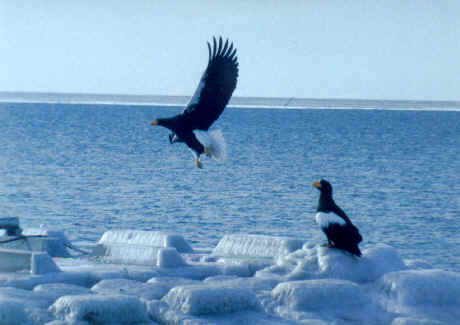
Steller's Sea-Eagles in
eastern Hokkaido
In January '07, along the
eastern Hokkaido coast, we saw a small and colorful bird that we don't normally
see on Hokkaido in the winter: a male Daurian Redstart. Usually we see it
further south. So, this time, we saw this species that only winters in Japan, on
all 4 of the islands that we visited (north to south: Hokkaido, Honshu, Kyushu,
and Amami).
During all of our 16 previous Winter Japan Birding Tours, we've seen the Blakiston's
Fish-Owl. Localized in Japan only in Hokkaido, it is one of the world's
rarest owls. (Occurring also in the wilderness of eastern Siberia, it's far from
plentiful there also - in that land where the Siberian Tiger lives.) It's
exciting to see the Blakiston's not only because it's rare, but also because
it's huge, being one of the largest of the world's owls. At dusk, we were at the
right spot. We heard first the deep call of the bird. Then, with their large
wingspans, two of them flew in to perch in trees near us! For FONT, it was the
Blakiston's Fish-Owl for the 17th time.
In the town where we spent a couple nights in eastern Hokkaido, there are some
shops where local people sell woodcarvings that they've made of the
Blakiston's Fish-Owl. After seeing the owl in life, it was nice to see (and buy)
the woodwork in the store. Being in Hokkaido is such a great experience, so far
away from the world in which most of us live.
Down the road, from the town with the shops, the Hokkaido experience is
reinforced in the morning, as Whooper Swans swim and call enshrouded by
mist in the waters of a big lake. Those noisy Whoopers are only in Hokkaido
during the winter. When Hokkaido warms up, they go north to Siberia, where they
breed.
The Red-crowned Cranes in Hokkaido, also vocal, are there, however,
throughout the year. They don't leave. In the winter, however, they flock up
together at certain places, where watching them is one of a birder's highlights
of a lifetime. Also known as Japanese Cranes, these tall stately birds
can be seen in the winter, against a beautiful snowy background, jumping into
the air, and can be heard making their bugle-like sounds. In the first half of
the 20th Century, that sound nearly became silenced when the species in Japan
flirted with extinction. It was nearly as rare as the Whooping Crane of North
America. How great it is that both species were not lost, when really they very
well could have been. Today, there are about 900 Red-crowned (or Japanese)
Cranes in Hokkaido (the only place in Japan where they occur). We saw at one
place more than 200 of them.
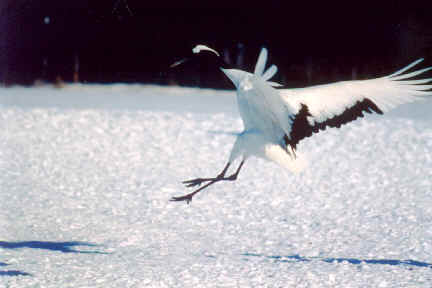
Red-crowned (or Japanese)
Crane
Seeing the cranes in
Japan is of course a wonderful experience, but it can enhanced by the reading of
a book, published not that long ago in 2001, "The Birds of Heaven - Travels
with Cranes", by Peter Matthiessen. There's a chapter in that well-written
book about the Red-crowned Cranes in Hokkaido.
As good as it is that now there are nearly a thousand cranes in Hokkaido,
in Kyushu during the winter, there are about
7,000. They come to one particular area there every year from mainland Asia,
where in the summer their nesting area is spread across many miles of mostly
Siberia. In the winter, however, they come to be together in a large grouping of
about 5,000 Hooded Cranes and 2,000 White-naped Cranes. Adults and
young of the year are seen together, among the large flocks.
For years, we've come, from other parts of the world, to see these birds. Again,
as with the cranes on Hokkaido, it's quite an experience. Every year, a few
cranes of other species are also in the flocks. Every year, we've seen Common
Cranes and Sandhill Cranes, as we did again in January '07. Some
years, there have been Siberian Crane and Demoiselle Crane. During
the 2006-07 winter, birds of those 2 species were not in Japan.

Hooded & White-naped
Cranes in Kyushu
Cranes are not the only
birds that come to Kyushu, Japan from mainland Asia to spend the winter. Not far
from the cranes, we saw some small birds in the reeds that did the same thing: Chinese
Penduline Tits and Pallas's Reed Bunting (another Asian bird named
after Peter Simon Pallas). Having done the same type of journey were the Daurian
Jackdaws that we saw mixed in among the Rooks (also from mainland
Asia) on the telephone wires. The Northern Lapwings and Temminck's
Stints that we saw on the fields did the same thing. They, too, are only in
Japan during the winter.
The cranes that winter in Kyushu are well-known in ornithological
circles. Not as well known, in Kyushu in the winter are the large flocks of Mandarin
Ducks present there only during that season. They are on the other side of
Kyushu. We enjoy seeing them along a particular river in a valley surrounded by
forested hills. During a day, we see at least a couple thousand of these
beautiful ducks, with different colors but otherwise similar to the Wood Duck of
North America. The Mandarins that winter in Kyushu are shy. The flocks fly up
quickly from the aqua-blue water of the river. In a telescope, and with
binoculars, observing the large number of Mandarins is yet another wonderful
Japanese experience.
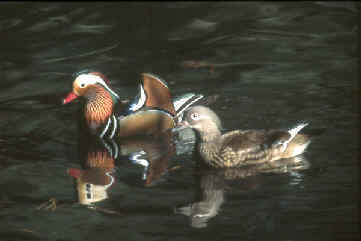
Male & female
Mandarins
In January 2007, as we were having this experience, 2 Mountain Hawk-Eagles were soaring in circles overhead above the forested hills. Not far away that day, on the ground, there were Olive Tree Pipits walking about, and a White's Ground Thrush feeding. In trees, nearby, Japanese Grosbeaks were doing the same, eating berries. By a temple, during our time in Kyushu, there was more activity in trees as Japanese Macaques, also known as "Snow Monkeys" were moving about.
We had so many wonderful experiences during our January 2007 Winter Tour in Japan.
![]()
Guatemala
December 2006/January 2007
Links:
Photos
of Nature & Scenery from our Guatemala Tour Dec '06/Jan '07
Birds & Other
Wildlife during our Guatemala Tour in Dec '06/Jan '07
Cumulative List of Birds during our Guatemala Tours
Upcoming FONT Birding & Nature Tours in Guatemala
The following account was written by Armas Hill, leader of the tour:
At the end of our Dec 26, '06 to Jan 4, '07
Guatemala Tour, as we sat in a hotel restaurant, we each wrote on pieces of
paper what it was we liked the most about our just-finished trip. We usually do
such a thing listing the "top 10 birds" or so, but this time we opted
to include also the over-all experiences, the places, and whatever else, in
addition, of course, to the birds.
Number #1 was one of us was "seeing so much of a very different country -
starting with the VOLCANOES". Yes, those lofty, high volcanoes were hard to
ignore when we were there, and equally hard later to forget.
The beautiful Lake Atitlan and vicinity was also high on that list, followed by
Antigua, the old capital city of Guatemala, with its colonial architecture,
pastel colors, and cobblestone streets.
Then, in his list, there was a bird. Highest-ranking in that category, for him,
was the colorful VIOLACEOUS TROGON that sat tamely in a fruiting tree above us.
TOUCANS and yet other colorful birds came and went. But the TROGON stayed still.
(I remember , too, my first encounter with a tropical trogon years ago.)
Then, in the list of favorites, there were the MONKEYS, both HOWLER MONKEYS and
SPIDER MONKEYS. One afternoon, as we were traveling along a river by a remote
Mayan site up above a cliff, the boatman, as we requested, turned off the motor.
There was quiet, except for the song of birds (wrens were singing, others were
calling), and the roaring, yes, ROARING, of the HOWLER MONKEY. If people
traveling up such a river, whenever, did not know the source of that loud sound,
what did they ever imagine?
Next on the list was the ARACARI, another colorful culprit in that fruiting
tree. A small toucan, it's a bird that exemplifies the tropics.
Then, on the list, Tikal, with its temples in the jungle. What a place it is to
visit, and what a place to bird.
Early in the tour we took a boat-trip in an area of extensive marshes near the
Pacific Ocean. There were birds, many of them. Late in the afternoon, it was a
good time for that boat-ride. Against the sky, in the good light that afternoon,
as looked inland, away from the Pacific, there were those Guatemalan volcanoes.
Simply put, they were impressive. It was a beautiful afternoon. As dusk ensued,
the sky, for a while, was filled with flying NIGHTHAWKS - dozens of them -
LESSER NIGHTHAWKS they were.
Often as we walked in the area of Tikal,
there were birds in the trees. Many were small; some were large. Among the
biggest was a single CRESTED GUAN that stayed there, somewhat clumsily moving
about, above us.
Not as large as a guan, but big enough, another bird was a bit more adept as it
moved about in a tree. It was the SQUIRREL CUCKOO, moving a bit as it did rather
like a squirrel.
And last on that first list was the CROCODILE. It was big, very big, across the
way on the bank of a pond. Its mouth was wide open, and let me say, we didn't
need our binoculars to see its teeth.
On another person's list, number #1 was the PINK-HEADED WARBLER. And deservedly
so. It's a brilliant bird, mostly red, with a frosty head, living in the pines
and oaks of the Guatemalan mountains.
Number #2 was the ORNATE HAWK-EAGLE. One morning as we were on a high slope of a
volcano, 2 of them flew by above us, one after the other. The species was the
second Hawk-Eagle of the morning for us. We had just seen the BLACK-AND-WHITE.
We were just about to see the BLACK. Incredible it was to encounter 3 species of
HAWK-EAGLES in just a couple hours.
Another morning as we were traveling in the northern Guatemalan region called
the Peten, not really near anything, there was in the sky ahead of us, a large
kettle of big birds lifting up in a thermal. We stopped and looked up. They were
WOOD STORKS, about a hundred of them, soaring in circles. It was a truly nice
sight.
Next on the was the BLACK-AND-WHITE HAWK-EAGLE mentioned a moment ago. We had
such a good look at that marvelous raptor.
During the tour we were never along the seacoast, the haunt of the BROWN
PELICAN. So we didn't really expect to see them. But twice we did in the remote
Peten. Once, along a river, where it widened into almost a lake, they sat on the
water, 6 of them. Another day, by the edge of what was a large lake, we saw a
bigger group of those large birds, in flight. There were 17 of them, like a
squadron, as they passed by. Also in that area, by the way, was another bird
usually by the sea, a ROYAL TERN. And interesting also, there was a single
LESSER BLACK-BACKED GULL with the LAUGHING GULLS on pilings. During the FONT
tour there, 2 years ago, we saw one LESSER BLACK-BACKED GULL.
Did I mention that when we were on that slope of the volcano, where we saw the
HAWK-EAGLES, there was an EARTHQUAKE? Well, there was. It was a mild one, but it
made the list of favorite things of the trip.
The SQUIRREL CUCKOO got another vote. Also getting votes were the KEEL-BILLED
TOUCAN and the MONTEZUMA OROPENDOLA. It's not hard to understand why. Both were
fun to watch, and the oropendola, also, fun to hear.
Then there was the pair of ORANGE-BREASTED FALCONS at Tikal. One perched high in
a tree. Another called nearby. ORANGE-BREASTED FALCONS have been seen during
FONT tours at Tikal in 2002, 2004, 2005, 2006, and now, 2007. Probably no where
can they more readily seen than at Tikal.
Another trogon got a vote, the MOUNTAIN TROGON. Yes, it's a bird of the
mountains, and a nice one at that.
The MONKEYS got another vote. The IGUANA was not forgotten. And the OWL
BUTTERFLY that we saw so nicely along a forest trail was not only not forgotten.
It was very well remembered. Photos of it, and a number of the other
vote-getters that we've mentioned here, are elsewhere in this website (the link
precedes this narrative).
Let me, if I may, give my "Top Ten" of the tour, before concluding.
All of them, of course, are birds:
* the 3 species of HAWK-EAGLES during 1 morning
* the ORANGE-BREASTED FALCON
* an ANT SWARM with a frenzy of birds including: various WOODCREEPERS,
GRAY-HEADED TANAGER, GRAY-THROATED CHAT, and others
* the PINK-HEADED WARBLER
* the BLUE-THROATED SAPPHIRE (a nice hummingbird in the forest; during the tour
there were over 15 species of hummingbirds)
* the PREVOST'S GROUND-SPARROW (a truly dapper bird!)
* the CHESTNUT-COLORED WOODPECKER (we saw it so well; it was so nice to see)
* HOODED WARBLERS (even though they're in our North American woodlands in the
summer, they're always nice to see! - as were the many WOOD THRUSHES we saw at
Tikal)
* the WOOD STORKS in the large kettle already mentioned
and lastly,
* the VERMILION FLYCATCHER. In a Spanish-speaking country, I like to call the
brilliantly-red male the "brazito de fuego", "that little ball of
fire".
Also in terms of color, it's deserves mentioning that we saw 7 bright species of
ORIOLES during the tour.
There were 260 species of other birds, as the total for the trip was 267.
Guatemala has been the destination for a number of years now for our annual
December/January Holiday Tour. Prviously, we went, for a number of years, over
the holidays, to Costa Rica. We've also done Dec/Jan Holiday Tours in southern
Spain and in the Caribbean, in the Dominican Republic. (In December
2007/January 2008, our Holiday Tour was to be to the Caribbean again, to the Lesser Antilles
- to the islands of Saint Lucia, Saint Vincent, and Domincia, for parrots and
more. - And that it was. With Guatemala to be scheduled again for our annual
Holiday Tour in December 2008/January 2009.)
![]()